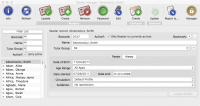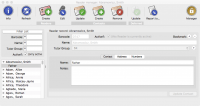Table of Contents
General Reader Manager Layout
 As with many of the dialogs within Pergamon, the Reader Manager dialog follows a standard pattern in order to ease end-user learning of the system.
As with many of the dialogs within Pergamon, the Reader Manager dialog follows a standard pattern in order to ease end-user learning of the system.
The left-hand side of the dialog contains a basic filtering system and a list of Reader and associated contacts within the database. On selection of an Reader or contact in the list, the details of the record are displayed in the larger right-hand area.
The standard fields at the top of this section continually display the human-readable identification code of the Reader, the Reader's name, and whether or not the Reader is currently active, and the group into which the Reader has been placed. This latter field is important as the type of group determines whether the Reader represents an individual or an organisation.
 MU Users
MU Users
All data entry tabs in the Pergamon MU version of the software have been merged into a single page. You may also find that some data fields available on higher versions of Pergamon, such as the extensive Dynamic Indexing system, are not present on Pergamon MU.
Reader Tabbed Pages
The bulk of the information about the Reader is presented on a number of tabbed pages that can be displayed by right-clicking the title of each tab. As far as possible, each page only displays relevant and related information.
The Borrower page displays information that is dependant upon whether the Reader represents an individual or an organisation. With the Ptolomy release of Pergamon, the organisation Reader type contains no additional information and the page is therefore deliberately blank. The remaining pages are displayed for both Individual and Organisation types of Reader.
The Membership page contains information regarding the time period during which the Reader is an valid member, and also the circulations profile that is used to determine the rules in use for funcationality such as the Circulations package.
The Options page displays any dynamic indexes that have been created but which have only a single selection possible. The Gender of an Reader for example, would fall into this area as an individual may be 'Male' or 'Female', but not both.
The second dynamic indexing page, simply titled Indexing displays dynamic indexes that may have no, one or many selections possible. These dynamic indexes may include things such as spoken languages and disability information.
Contact Tabbed Pages
 The Contact page contains a descriptive name for the contact information, along with a large text field that can be used for notes. The Address tab contains fields that allow the entry of an address, while the Numbers tab allows the entry of contact telephone numbers and email addresses.
The Contact page contains a descriptive name for the contact information, along with a large text field that can be used for notes. The Address tab contains fields that allow the entry of an address, while the Numbers tab allows the entry of contact telephone numbers and email addresses.
As many contact records may be recreated for each Reader as required.
Note: Beginning with v1.0.96, the Contacts system on Pergamon MU is turned OFF by default. If you wish to use this facility, simple turn the system back on in [Lookup Manager] > [System Information].
Command Buttons
The command buttons along the base of the dialog allow the user to update the Reader or contact if it has been modified and start any advanced editor that is available for an Reader in this group.
